Kingston SSDNow V300 (120GB & 240GB) Review
by Kristian Vättö on April 30, 2013 12:30 PM ESTRandom Read/Write Speed
The four corners of SSD performance are as follows: random read, random write, sequential read and sequential write speed. Random accesses are generally small in size, while sequential accesses tend to be larger and thus we have the four Iometer tests we use in all of our reviews.
Our first test writes 4KB in a completely random pattern over an 8GB space of the drive to simulate the sort of random access that you'd see on an OS drive (even this is more stressful than a normal desktop user would see). I perform three concurrent IOs and run the test for 3 minutes. The results reported are in average MB/s over the entire time. We use both standard pseudo randomly generated data for each write as well as fully random data to show you both the maximum and minimum performance offered by SandForce based drives in these tests. The average performance of SF drives will likely be somewhere in between the two values for each drive you see in the graphs. For an understanding of why this matters, read our original SandForce article.
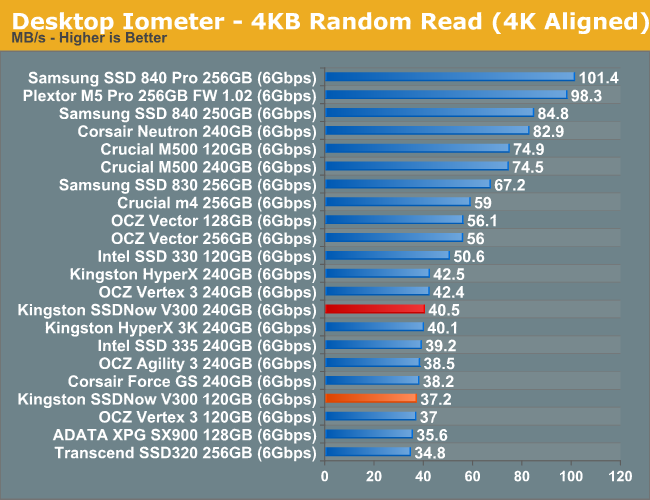
Random read performance is similar to other SF-2281 SSDs; only Intel has a small advantage here.

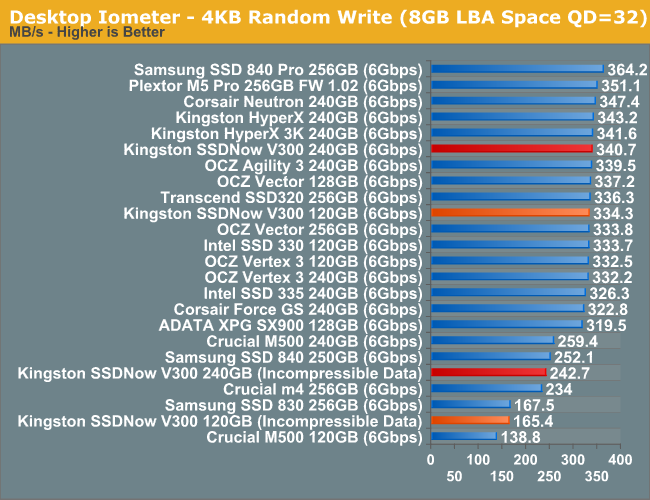
Random write speed is also typical SandForce. The 120GB model does take a pretty big hit when using incompressible data because there's less parallelism due to fewer NAND die.
Sequential Read/Write Speed
To measure sequential performance I ran a 1 minute long 128KB sequential test over the entire span of the drive at a queue depth of 1. The results reported are in average MB/s over the entire test length.

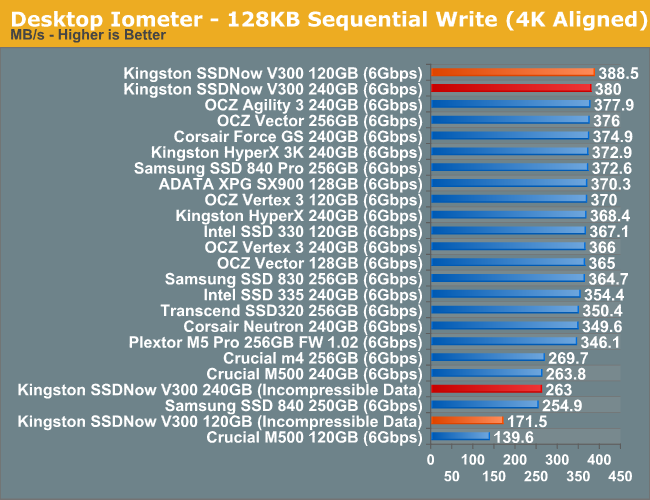
No surprises in the sequential Iometer tests either.
AS-SSD Incompressible Sequential Performance
The AS-SSD sequential benchmark uses incompressible data for all of its transfers. The result is a pretty big reduction in sequential write speed on SandForce based controllers.
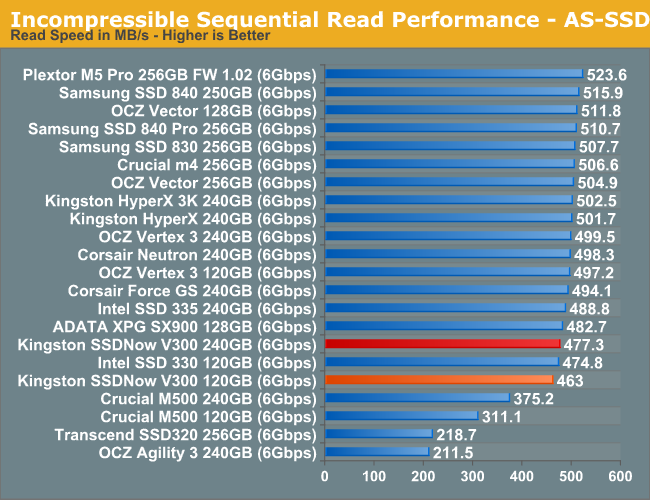
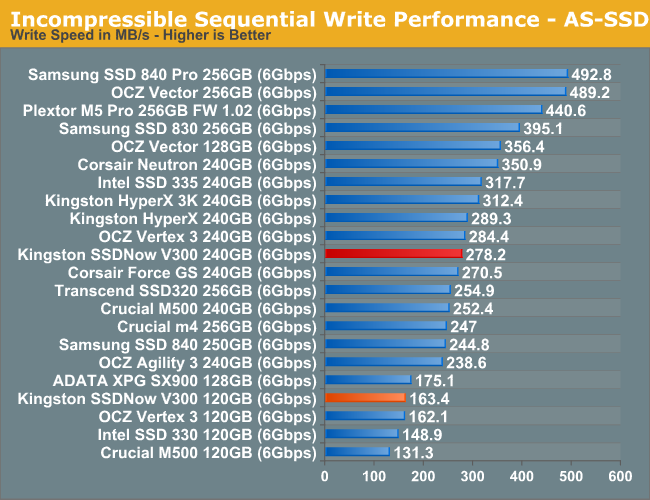










43 Comments
View All Comments
gamoniac - Tuesday, April 30, 2013 - link
Kristian, you forgot to throw in the SSDNow KC100 series in the mix :) It uses SandForce controller, too. That aside, I have five Kingston SSDs; some running 24x7 without issue (knock on wood). Kingston SSDNow lines are pretty attractive a year or two ago when they went on sale with $50 mail-in rebate on Buy.com and Newegg. Nowadays though SSD prices are a lot more competitive. I agree that they need to change their marketing/pricing strategy to stand out from the competitions.ericgl21 - Wednesday, May 1, 2013 - link
How did you TRIM the V300 in Windows 7? There is no "Optimize" option like in Windows 8.And the Kingston Toolbox v1.0 does not have it either (Intel SSD Toolbox does have it, but only works for Intel SSDs).
Kristian Vättö - Wednesday, May 1, 2013 - link
Formatting the drive in Disk Management triggers TRIM.Diagrafeas - Friday, May 3, 2013 - link
I don't understand this.Formatting should trigger Secure Erase.
If it only triggers trim then data isn't erased right?
Kristian Vättö - Friday, May 3, 2013 - link
Secure erase is a different command which cannot even be issued in Windows without specific software. Secure erase basically gets rid of the whole indirection table and erases all LBAs (even the ones inaccessible to the user which are used for e.g. garbage collection and wear leveling).TRIM, on the other hand, just tells the controller that these LBAs are no longer in use and the drive's garbage collection can get rid of them when the time is right. Formatting is the same as TRIMing all user-accessible LBAs, so the controller should get rid of (nearly) all data in the drive and hence returning it to fresh state (the problem is that garbage collection works differently in every SSD and the TRIM command is also treated a bit differently).
ericgl21 - Sunday, May 5, 2013 - link
So in Windows 7, there is no way to TRIM a Kingston SSD without losing the data on it?One must format it?
How come Intel SSD Toolbox can issue a TRIM command for Intel SSDs (which usually takes only a few seconds) without harming any of the user's data on it? They are based on Sandforce controller as well.
leexgx - Tuesday, January 13, 2015 - link
No its done as files are deleted (once a file is deleted the drive is told that it's gone and trim happens when the drive is idle)clarkn0va - Wednesday, May 1, 2013 - link
Kingston Value RAM is a great product in my estimation. It's priced reasonably, performs predictably and has a lifetime warranty, although you'll rarely need to exercise it.Kingston flash products, on the other hand, I'm totally finished with. I bought a dozen or so SSDNow drives about three years back and saw many of them fail in the first and second year. TRIM was never available on these drives, although the competition all had it, and firmware updates were non-existant.
Meanwhile, Kingston USB sticks underperform, and there is little consistency across product lines. From what I've read, Kinsgston-branded flash comes from a whole variety of manufacturers, resulting in poor and inconsistent performance.
I like my Kingston RAM, but for SSDs and USB storage, I'll stick to the proven performers.
SharpieTM - Wednesday, May 1, 2013 - link
I was going to say the same thing. I have a couple 32GB ECC Memory kits from Kingston running, and they are running well. Had more issues with Corsair Memory in my time than with Kingston.But on the SSD and Flash drive front, Kingston is far behind the competition. My feeling is that they are trying to charge for the logo and not the performance. This is a business strategy that will surely end bad. After a couple bad experiences with Kingston and OCZ, my current two go-to manufacturers for SSD's are Intel and Samsung. I have had zero issues with at least a dozen of them.
Deo Domuique - Friday, May 3, 2013 - link
The only reason I would consider buying this, is the 60GB version! I find the 60GB to be the perfect size for an OS/Updates/Drivers/Browser drive. No more, no less.